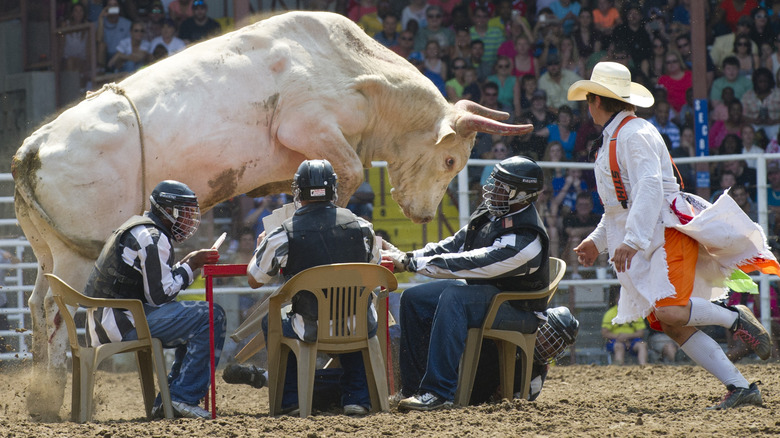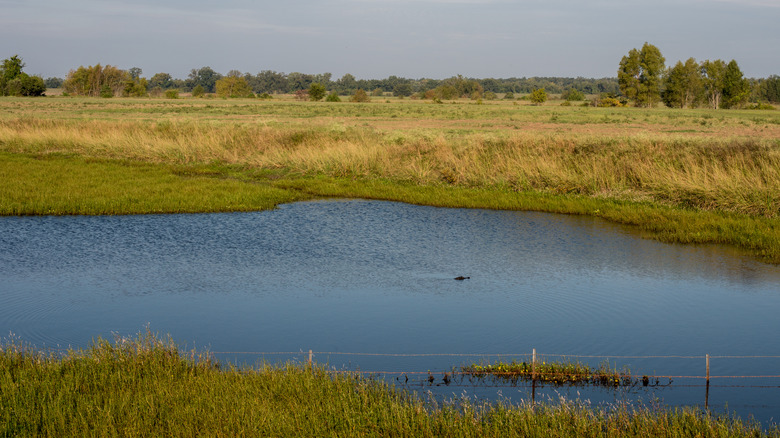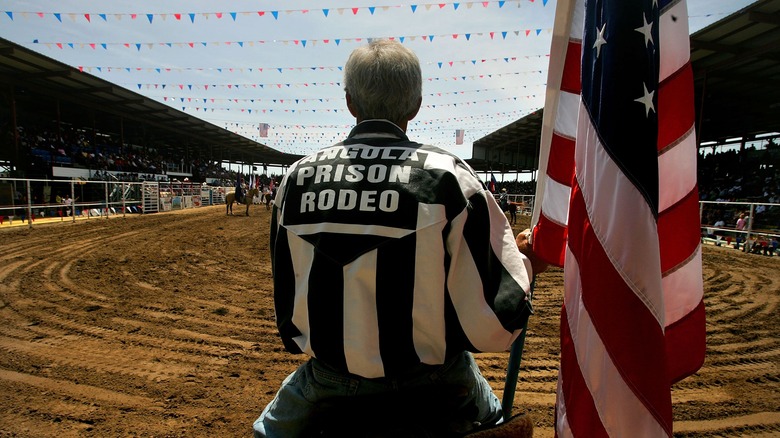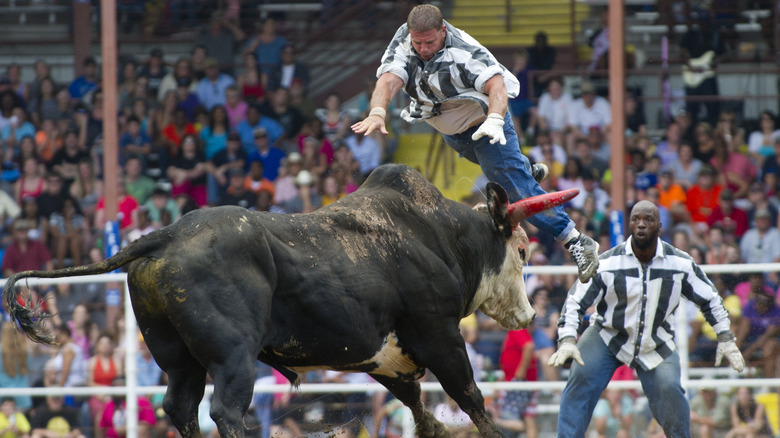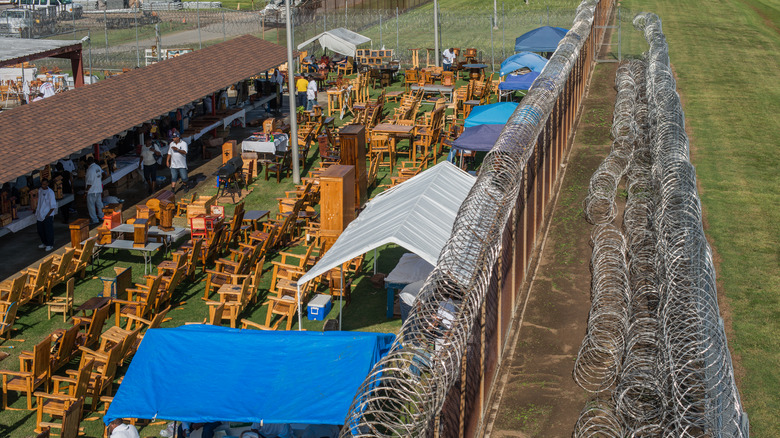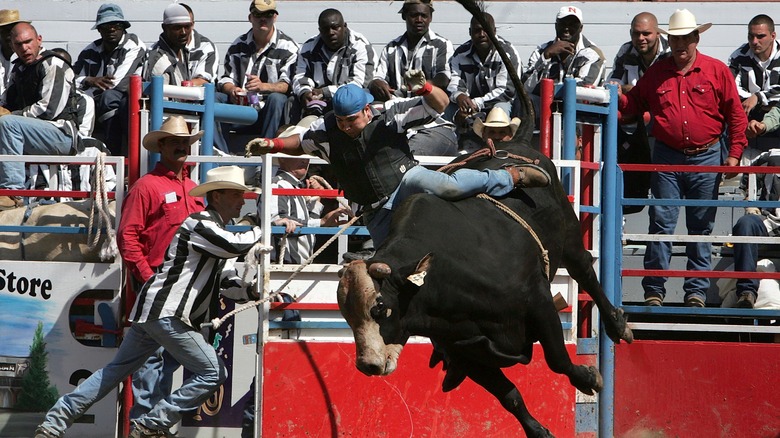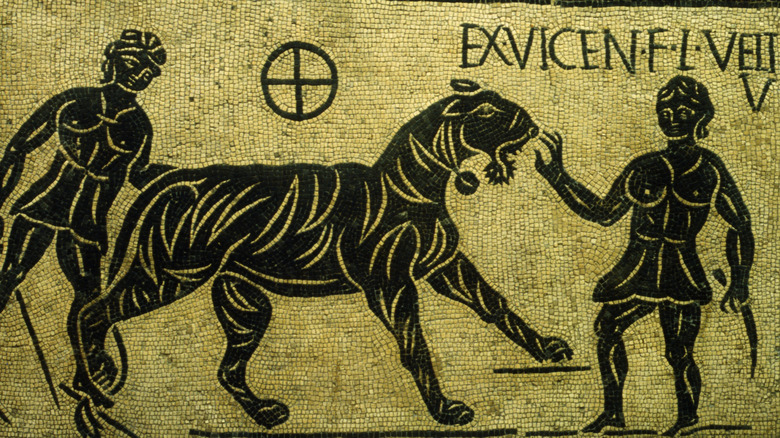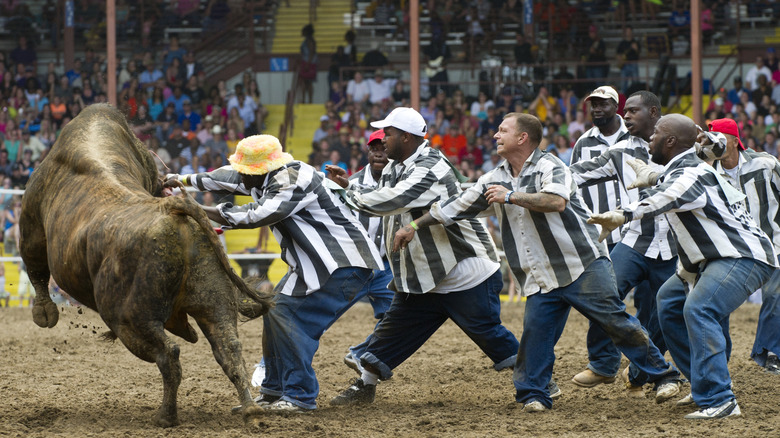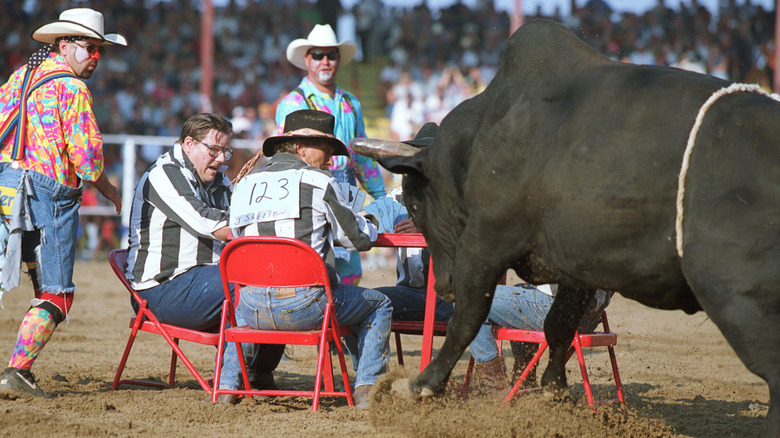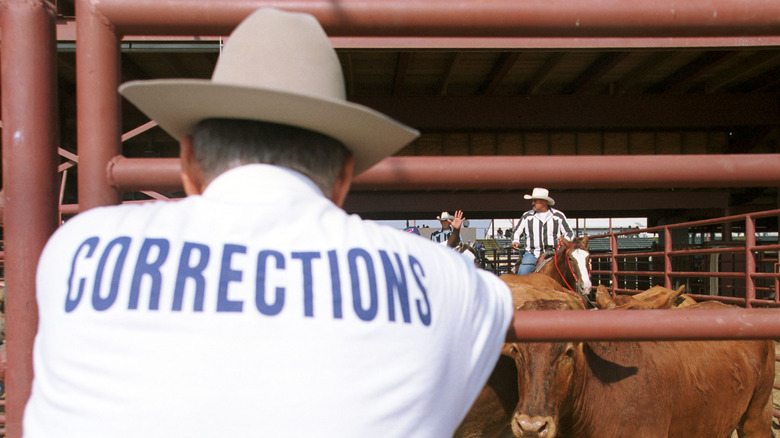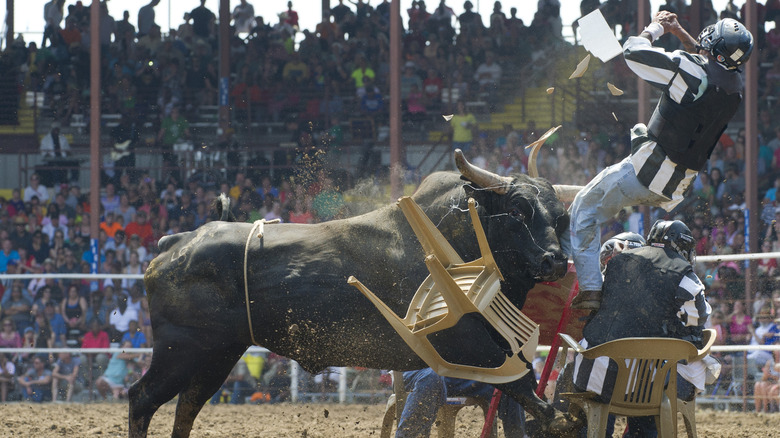The Messed Up Truth About The Angola Prison Rodeo
Although prison rodeos have been around as early as 1931, none of them have outlasted the Angola prison rodeo in Louisiana. The Angola prison rodeo has been around for over 50 years and remains the only prison rodeo that is still operational and remains known as the "wildest show in the South."
The Angola prison rodeo draws thousands of people and makes hundreds of thousands of dollars every year from what many refer to as gladiator-style fights, as imprisoned people are pitted against bulls, cows, and horses. And imprisoned people are purposefully kept inexperienced and without training to heighten the thrill for the crowd of seeing people make split-second decisions in dangerous situations. And although the Angola prison rodeo was put on hold due to the COVID-19 pandemic, it resumed in April 2022. However, considering that it's the last remaining prison rodeo in the United States and has been followed by scandals through the years, the Angola prison rodeo might be in its twilight.
From its small beginnings as a private rodeo within the prison, the Angola prison rodeo has transformed into an institution for the prison, with the majority of funding for the imprisoned people even coming from the rodeo revenue. But as stories of misappropriated and missing funds circle the rodeo, along with numerous stories of injuries, it's worth looking at exactly what the Angola prison rodeo entails. This is the messed-up truth about the Angola prison rodeo.
From plantation to prison
The Louisiana State Penitentiary, also known as Angola Prison, is located on the site of the former Angola Plantation. In 1880, the plantation was purchased by former Confederate Major Samuel L. James and first became a prison camp through convict leasing, known at that point as the James Prison Camp, according to The Angola Museum.
The Innocence Project writes that because of Jim Crow laws, also known as the Black Codes, newly emancipated Black people were frequently arrested and sent to prison, where they were then leased out as labor to private businesses through convict leasing. And when convict leasing was banned in 1898, the state of Louisiana purchased the plantation in 1901 and created the Louisiana State Penitentiary, "taking control over the prisoners previously leased to the plantation." The 8,000-acre plantation would grow to span 18,000 acres over the following century and as of 2022, imprisons over 5,000 people, making it one of the biggest maximum-security prisons in the country.
Many describe Angola Prison as "a place where slavery never ended," made possible by the fact that the 13th Amendment permits involuntary enslavement as a punishment for a crime. Meanwhile, 70% of Angola's population is sentenced to life in prison and 75% of the people imprisoned at Angola are Black. And although convict leasing has ended, the pennies that imprisoned people are paid per hour pales in comparison to the billions of goods and services that they produce every year.
Longest running prison rodeo
The first Angola prison rodeo was held in 1965 by a small group of imprisoned people and workers at the Angola Prison but the rodeo wouldn't be opened to the public until 1967. Via Nola Vie writes that the rodeo was initially intended to be entertainment for both the imprisoned people and the workers of the prison. Even when opened to the public, there were no stands for the spectators and people sat on apple crates and the hoods of cars to watch the prison rodeo, writes the Clarion-Ledger. But as the popularity of the rodeo grew, a 4,500-seat arena was built in 1969. Over the years, the rodeo has continued to grow and as of 2022, the new arena can hold over 10,000 attendees.
Imprisoned people that show good behavior are allowed to compete in various rodeo events, like bull riding and wild cow milking, in an attempt to win prize money or sell hand-made jewelry, paintings, and woodwork at the arts and crafts fair.
According to "Convict Cowboys" by Mitchel P. Roth, since the mid-20th century, there have been five other prison rodeos in the United States, but after the Oklahoma State Penitentiary prison rodeo closed in 2010 due to budget issues and pressure from animal rights groups, Angola prison rodeo became the longest-running prison rodeo in the United States. The Angola prison rodeo is typically held every Sunday in October and one weekend in April, writes The Guardian.
Cash prizes
Imprisoned people who compete in rodeo events can win cash prizes ranging from $15 to $500. And according to The Guardian, considering that the people imprisoned at Angola Prison are paid between 2 to 75 cents an hour for prison work, the rodeo becomes one of the only avenues for them to make money.
Rodeo events range from riding on bulls and horses to convict poker, which involves playing a game of poker while a wild bull is released. According to "Slaves of the State" by Dennis Childes, "a modest monetary prize is awarded to the man who remains seated the longest as a bull attempts to [gore] all four contestants." The man who can remain sitting in his chair the longest wins a total of $250.
The biggest cash prize of $500 is awarded for the most dangerous event called "Guts and Glory." The Huffington Post writes that for this event, the imprisoned person competing is tasked with retrieving a poker chip that's been placed between the horns of an irate bull that is released into the stadium. The horns are also painted red for effect. Despite how dangerous it is, many imprisoned people acknowledge that $500 is a lot of money in Angola, per Vice. According to The New York Times, the prize amounts have slowly increased over the years. In 1996, the prize for Guts and Glory was only $300.
Trustees
Imprisoned people who have been in the prison "the longest without incident" are known as trustees and are also allowed to sell their work at the craft fair. Racked reports that earning trustee status requires serving at least 10 years without incident. And while some imprisoned people will be forced to remain behind a barrier, and often also share their work through the fence, trustees are able to walk the grounds relatively freely. According to Gary Young, assistant warden for programming and communications director, the trustee status and ability to sell with a craft fair booth is considered to be a behavioral tool. "We extract an awful lot of good behavior [in exchange for a booth]," The Guardian reports.
Through the craft fair, some are able to make thousands of dollars in just a single day. In addition, Jessica Adams notes in "Wounds of Returning" that "despite the prison's Black majority, inmate cowboys [and trustees] seem as likely to be white as Black."
Tanya Erzen writes in "God in Captivity" that trustees also hold some of the most coveted jobs, including horse trainers, radio DJs, and coffin makers. Through this, they are able to "retain some modicum of control over their own lives, a precarious space of sovereignty within the vast prison."
Is it voluntary?
Although prison officials repeatedly assert that no one is forced to participate in the rodeo, the fact that the cash prizes are some of the only ways that imprisoned people can make money has many questioning whether or not participation is truly voluntary. According to The Guardian, "the economics of the prison system challenge the definition of choice." Aldrie Lathan, who has competed in the rodeo for nine years and suffered broken bones, concussions, and a dislocated shoulder, has stated, "I don't really have that much outside help, so instead of calling and asking family members for money, I come out and participate in the rodeo and try to do everything on my own."
The Title Magazine also writes that despite the fact that participation in the rodeo is claimed to be entirely voluntary and that some imprisoned people speak highly of being able to participate, "consent seems tricky when you don't have freedom." And for many of the people who are imprisoned for life, what choice or risk is there if there's nothing other than imprisonment ahead of them. Guernica notes that even getting killed by a bull would essentially amount to an end to the life sentence.
Meanwhile, other imprisoned people like Todd Plaisance state that "The rodeo actually made me be a better person. Without the rodeo, a lot of us would not be here today to come out here and give it our all," per WAFB9.
Akin to gladiator fights
Many have compared the Angola prison rodeo to Roman gladiator events. In "Slaves of the State," Childs notes the comparison to gladiatorial events that forced enslaved people to fight with animals and one another as well as the fact that one of the opening ceremonies of the Angola prison rodeo included "the prison's current warden entering Angola's arena in a horse-drawn chariot driven around its perimeter by prisoners."
Wits Justice Project describes the Angola prison rodeo as a "perverse mix between a gladiator fight and a rerun of the Hunger Games" that is demonstrative of the intentional cruelty of the American criminal justice system. Although the battle between the imprisoned person and the bull isn't a fight to the death as it was during gladiator contests, "Rituals and Traditional Events in the Modern World" notes that in both instances the animal is representative of the "brute power of the state to inflict bodily harm (punishment) on the person deemed to have transgressed."
And according to Thrillist, in an attempt to lighten the mood and dissuade too many gladiator comparisons, the Angola prison rodeo also includes monkeys riding dogs, throwing a hint of the circus into the gladiatorial rodeo. American Cowboy describes the Angola prison rodeo as part gladiator contest, part Stooges comedy, and part tent revival: "The so-called Angola Rodeo is the last vestige of a U.S. penal tradition that died out decades ago."
No training
Imprisoned people who participate in the Angola prison rodeo have no opportunities to practice and receive no training before the actual rodeo events. The Guardian reports that prison officials insist that professional cowboys, rodeo clowns, and medical professionals are reportedly always present at the events to address serious injuries, but because the imprisoned people interacting with the animals are inexperienced, injuries occur more often than not. And this is considered to be a selling point for the Angola prison rodeo, which notes on its website that the imprisoned people participating in the bull riding will be inexperienced and describes the event as "dangerous." And the bull used for Guts and Glory is described as "the meanest, toughest Brahma bull available."
According to former professional bull rider Bubba Dunn, "If you're looking for a quality horse ride, bareback ride or a quality bull ride, that ain't gonna happen here, because [the inmates] don't ever get to practice and they don't know what's goin' on," per SportsNet.
Kristopher Schoening, who's imprisoned at Angola, has said that "It would be nice if we had training. But it's also pretty awesome when you win the event and you ain't had no training," per Al Jazeera. And it was only after numerous reports of serious injuries that helmets, mouthguards, and vests were required for participating imprisoned people.
Horrific injuries
Because everyone participating in the rodeo itself is inexperienced, horrific injuries have been known to occur at the Angola prison rodeo. And even those who've participated in numerous rodeos still end up with injuries, like Aldrie Lathan, who's suffered numerous injuries despite competing in at least nine rodeos at Angola Prison. Childs writes in "Slaves of the State" that imprisoned people are frequently tossed over 20 feet into the air by the animals and frequently end up with broken bones, gouged limbs, and concussions. And in addition to injuries sustained during the prison rodeo itself, many also continue to suffer from ongoing chronic conditions as a result of competing in the rodeo. Some are even missing muscles in their body after having them gored out by one of the bulls.
"One prisoner is known to have ultimately died from a heart attack resulting from his participation in one of the events," and Prison Legal News reports that even then-Angola Assistant Warden Cathy Fontenot acknowledged serious injuries occurring during the rodeo as well as deaths. According to the Critical Mass Program, Johnny Brooks was gored by a bull in 1999, one year after being featured in God of the Rodeo.
According to former Head Warden of Angola Prison Burl Cain, "We don't want anybody hurt because it costs us lots of money," per My Statesman. Despite this, younger and especially less-experienced imprisoned people are repeatedly encouraged to participate.
Rodeo funds
In a single day, the Angola prison rodeo can make up to $450,000 a day and raise $1 million in ticket sales alone in a year. And at over $20 a ticket, the 10,000-seat arena is typically sold out. And according to The Guardian, the rodeo's revenue is used to pay for numerous programs for imprisoned people in Angola, including trade schools, activity clubs, and the prison hospice. "Many clubs set up rodeo concession stands, where they raise an estimated $80,000 a day."
Rodeo revenue is also used to fund the re-entry program, which puts imprisoned people into a GED program and trades them for certification in a trade. And because of budget cuts, some of the community college instructors have been replaced with people serving life sentences who have also completed educational programs. "Their pay – 75 cents an hour – is also subsidized by the rodeo." USA Today also reports that rodeo funds are used for Baptist seminary classes at the prison and maintenance of the six chapels in the prison. And with more and more budget cuts affecting the prison, funds from the Angola prison rodeo end up being used to subsidize the majority of programs for imprisoned people.
Imprisoned people selling their work at the Angola Prison Hobbycraft Sale, which occurs alongside the rodeo, can also make hundreds of dollars but because "much of that money typically goes to buying more supplies, funds for necessities can be scarce," according to Atlas Obscura.
Auditing the prison rodeo
After an investigation in 2017, the Louisiana Legislative Auditor found that the Angola prison rodeo had potentially violated state law several times. According to the Louisiana Legislative Auditor, former Warden Burl Cain was implicated in several of these violations, including using $27,520 in public money on personal appliances for his house at the prison. In addition, it's estimated that over $6.3 million that was generated by the Angola prison rodeo between 2014 and 2015 was never included in the Department of Corrections' budget or deposited with the State Treasury.
"In addition, between April 2010 and October 2015, $27,918 in rodeo concession sales revenue was never deposited into the Committee's credit union account." The money apparently just went missing and officials at Angola couldn't provide any information as to what may have happened with the money. It was also discovered that the Angola prison rodeo Committee donated over $65,000 to the Louisiana State Penitentiary Museum Foundation to purchase a bus. And because there was no agreement that showed that the prison received anything in return, the donation can be considered an improper donation of public funds and a violation of the state Constitution.
NOLA also reports that because the rodeo's revenue hasn't ever been held by the state treasury, "the rodeo money hasn't been monitored by [the] Louisiana state government since it began over 50 years ago." In response to the audit, rodeo revenue has been housed at the state treasury since 2017.
